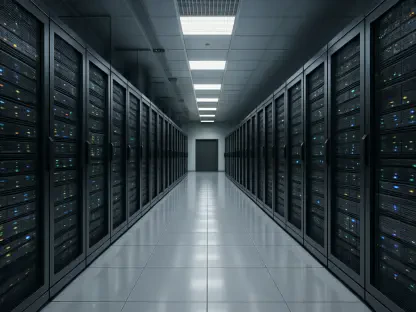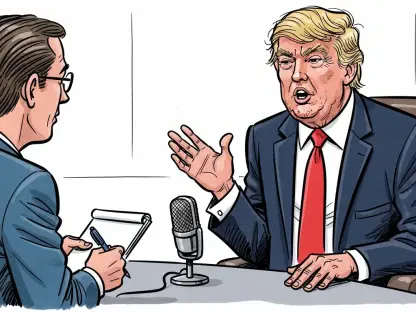The House Republicans’ plan to increase the U.S. debt ceiling by $4 trillion has sparked a robust debate both within the Republican Party and in broader political circles. This initiative, tied to President Trump’s tax agenda, aims to push forward a comprehensive financial strategy while bypassing potential roadblocks from Democratic opposition. Yet, the plan’s reception has been far from unanimous, leading to internal GOP strife and a politically charged legislative landscape as experts weigh in on the associated challenges and potential outcomes.
Navigating Economic Challenges and Political Pressures
Setting the stage for this political tumult, economic analysts emphasize the dual pressures facing lawmakers: the mounting $36 trillion national debt and the imperatives of political gain. The plan to link the debt ceiling hike with tax reforms seeks to streamline legislative priorities by merging critical issues. Analysts warn, however, that this move heightens the stakes and accelerates the legislative timeline, leaving little room for negotiation or delay. Ultimately, the convergence of these efforts places significant pressure on the legislative apparatus to perform under tight deadlines and demands a careful balancing act to avoid economic pitfalls.
Experts stress that political pressures compound this scenario, with Treasury Secretary Scott Bessent advocating for swift action to prevent a government default. The urgency underscores the complexity of entwining economic policy with political strategy, as Republican leaders strive to deliver significant fiscal reform while managing intraparty divisions and external relations. This complex interplay reveals the intricate dynamics lawmakers must navigate to accomplish their objectives without precipitating a fiscal crisis.
House Republicans’ Strategy vs. Internal Divide
House Republicans champion their strategy as a means of promoting tax reforms essential for economic revitalization. Their approach hinges on a swift increase of the debt ceiling interwoven with President Trump’s broader tax policy ambitions. Despite this unified front, dissent among GOP members revolves around key budgetary issues, such as Medicaid reform, which poses substantial challenges. Within the party, divisions persist as differing visions for budget savings and fiscal responsibility collide with broader strategic goals.
In contrast, Senate Republicans present a different approach with their proposal for a $5 trillion increase, aiming to secure financial stability through upcoming election cycles. The divergence between House and Senate Republicans illustrates a significant rift within the party, as factions weigh the potential benefits of a larger increase against perceived fiscal irresponsibility. This internal chasm highlights the complexity of reconciling contrasting fiscal ideologies while working toward cohesive party objectives.
Dissecting Economic Ramifications and Political Strategy
Examining the legislative landscape reveals historical precedents in which both parties have grappled with debt ceiling challenges. Economic historians point to numerous past instances where negotiations reached critical impasses, underscoring the necessity for bipartisan cooperation in overcoming fiscal hurdles. The current scenario mirrors these past challenges, as lawmakers endeavor to balance economic stability against political ambitions.
Evaluations of the debt ceiling debate illustrate the broader implications of political strategy on economic stability. Experts caution that while increasing the debt ceiling is essential, it inherently demands careful strategic consideration to mitigate potential fallout. The GOP’s current struggle underscores the persistent tension between economic imperatives and political maneuvering, with lawmakers striving to align strategic interests in a manner conducive to national financial health.
Bridging the Gap: Seeking Consensus
In the midst of this political storm, achieving consensus emerges as a paramount goal for lawmakers. Efforts to bridge gaps between divergent factions exemplify the complex negotiations required to attain legislative unity. However, key obstacles persist, with Medicaid reforms and budgetary disagreements contributing significantly to ongoing discord. Analysts emphasize the need for renewed dialogue and collaborative engagement to navigate these internal divides effectively.
The shifting dynamics within the GOP further complicate the picture, as new trends and power shifts reverberate through the party ranks. The traditional approach to debt ceiling debates faces scrutiny and calls for reimagining strategies in response to evolving circumstances. Such transformative thinking drives the party toward innovative solutions and approaches, laying the groundwork for potential breakthroughs in policy and legislative cooperation.
Practical Lessons and Future Considerations
Summarizing key insights from the debate, analysts impart practical lessons for stakeholders navigating the political landscape. Acknowledging the multifaceted nature of the debt ceiling discussion, they underscore the importance of informed decision-making and strategic engagement. For policymakers, balancing economic imperatives with political realities necessitates a nuanced understanding of legislative intricacies and stakeholder priorities.
Looking toward the future, sustaining relevance in an ever-changing political environment remains a top priority. Advocating for long-term strategies that transcend immediate fiscal challenges is crucial for ensuring ongoing economic stability. By fostering informed advocacy and strategic foresight, lawmakers and stakeholders alike can shape the future trajectory of fiscal policy and secure the enduring significance of debt ceiling negotiations.









